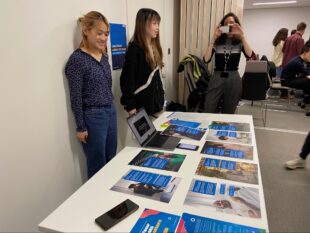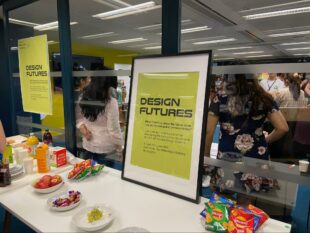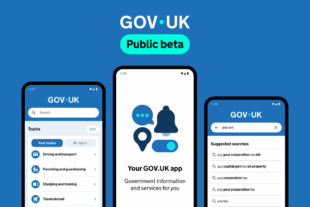
As a new academic year begins, students across the UK will be getting back into the swing of university life - or even having their first exciting experience of higher education. At the Government Digital Service (GDS) we’re always keen to work with the next generation of designers, researchers and strategists as they learn skills that will help them in their future careers. Recently we teamed up with University of the Arts London (UAL) and their MA Service Design students to envision what GOV.UK could look like in years to come.
GOV.UK has been on a remarkable journey since its launch more than a decade ago. Replacing nearly 2,000 separate websites with just one, our pages have been viewed 34 billion times since go-live, and YouGov polling shows we’re extremely well known. But change is a constant, and the digital landscape will likely look very different in 10 or 15 years’ time, with new platforms and ways of interacting digitally having emerged.
This project was led by Dr Lara Salinas and Marion Lagedamont in close collaboration with the GOV.UK team at GDS. It was delivered as part of the MA Service Design curriculum at UAL’s London College of Communication, and involved 41 postgraduate service design students for 8 weeks. The course teaches students speculative techniques to help them explore alternative futures with public organisations.Our collaboration provided the students with a chance to apply their skills in a real-world context, and allowed GDS to explore innovative approaches to the possible connections between users, technology and policy in the future.
Why it helps to envision the future
There are many advantages to taking a speculative approach to design. For example, if the last few years have taught us anything, it’s that we must be prepared for change. Looking into the future and interrogating what could be helps us anticipate and proactively engage with possible scenarios.
It’s also a more user-centred, resilient approach to meeting users’ needs for public services and information. Through user research, trends analysis and forecasting techniques, it means unintended consequences are considered and we can identify where people’s needs may not get met.
It also reinforces lateral thinking, and acts as a lens through which to review our current practices and ways of working.
Finally, everyone likes to talk about the future. As naturally curious beings, and as agile practitioners, we like to explore and test our hypotheses.
The brief
We set the students a brief with the guiding question: “What does GOV.UK offer its users in 15 years’ time?”. The brief was deliberately wide-ranging, to allow for creativity and breadth of exploration, and we set a timeframe in the near future to ensure the ideas were not too speculative.
Many of the students were also not from the UK, which meant they needed to be briefed about GDS’s history to give them context on our values and culture. We also gave students access to our designers and their skills, and met with students 3 times during the project to give feedback and critique their work.
At points throughout the project we also brought in industry experts to give talks on important topics, such as power and privilege in design, and how we approach user research at GDS.
How the students approached the question
The students used Critical Service Design techniques to imagine a better future by creating fictional services. First, they questioned their own biases and assumptions about what's possible or what a good outcome would be. This is tricky, especially for designers used to solving problems quickly, and students realised their ideas of the future were often influenced by advertising, books and movies.
Next, the students did thorough research on emerging trends in politics, economics, society, technology, law, and the environment worldwide. This helped them to ask "what if" questions that reframed the problem and explored new possibilities. They answered these questions with quick prototypes of fictional services and we gave feedback where ideas were considered impractical, too radical or were felt to paint an overly negative picture of society's future. We gave strong feedback on ideas that didn’t meet the brief, that were not in the best interests of people, or focused solely on technology.

One idea imagined a Ministry of Biodiversity, a fictional department. This led to imagining services for reporting sightings of bears, checking times when rivers were closed for fish spawning, and obtaining an apprenticeship and qualification in biodiversity law.
We then invited GDS staff to try out these fictional services. Interacting with them gave the students a chance to take part in discussions about the positives and negatives of these alternative futures.
Holding an exhibition
We decided to share our work by holding a design exhibition at the GDS office in London. The students had created many hands-on prototypes and other tactile materials like posters and leaflets that could be interacted with, to increase the level of engagement from staff at GDS.

For the afternoon event, students set out stalls displaying their work. We invited many senior members of GDS staff, as well as special guests from academia who had a particular interest in speculative design. We started the event with an intro from GDS leaders. We then encouraged people to interact with the exhibits and ask probing questions to fully understand the work of the students.
What we learned
As with all projects there were parts that worked well, and parts we would change. It served as a great reminder that we should adopt a balanced view of the future while engaging in speculative design, in order to generate more helpful ideas. Exploring preferable, possible and probable futures is a common framework used in this design approach, giving us the opportunity to consider risks society may face. However, we needed to give clear direction to students who were producing work that concentrated solely on negative scenarios, asking that they focus on positive concepts too.
Setting a broad question for the brief was a good thing - we got such a range of responses from students. This gave us a great starting point to narrow down and focus their projects using our design and research expertise.
Involving a mixture of students and GDS designers created a healthy tension. It meant the projects maximised the focus on user needs, accessibility and usability, while pushing the boundaries of what was possible. Inviting students to GDS was invaluable - it helped them feel more engaged with the brief and the work, and opened up conversations between staff about how GOV.UK might operate in the not-so-distant future.
We’re always looking for interesting collaborations, so please get in touch if you’d like to explore an idea together.
Subscribe to Inside GOV.UK to find out more about our work.
 The GOV.UK app went live in public beta in July 2025. Find out what’s been happening, and what’s coming next,
The GOV.UK app went live in public beta in July 2025. Find out what’s been happening, and what’s coming next,
2 comments
Comment by Vanessa posted on
Great to see your outreach work in this direction. Has it impacted your way of working now, or how you think services can be designed?
Comment by Laura Yarrow posted on
Hi Vanessa,
Thanks for your kind words. The project definitely encouraged us to work with design futures techniques, and we have built on this experience with outreach work and user research sessions, which has fed into project team delivery.
Best regards,
Laura Yarrow